Fatima and Taize are very different, but both are places of pilgrimage, and both manifest the diversity in unity that is a mark of the presence of the Holy Spirit. Both attract young people like bees to a honeypot, and hence both are important instruments of the New Evangelisation.click on:
I have never been to Fatima, being a Lourdes man myself. I was put off by all the apocalyptic talk and the secrets etc. In contrast, Lourdes seemed to me to be so straight forward, pure gospel stuff. I have often said that if anyone wants to know what Catholicism is about, just go to Lourdes, to the grotto and the hospitals, have a beer at one of the tables in the street, talk to pilgrims and watch all the variety going to and from the shrine; also pass time in the grotto at night, praying the rosary and soaking in the atmosphere.
I was wrong about Fatima: its message is extremely important: ordinary people can change the world by prayer and penance. That is our privilege and responsibility. God loves all, and belonging to the Catholic faith is not so much a privilege as a task. We are a priestly people who intercede for one another and for the whole human race, uniting it to Christ in our eucharistic prayer and through the quality of our christian lives. Thus, St Therese of Lisieux never left her convent but has become patron saints of missions, and Our Lady promised the children at Fatima that the prayers and penances of Christians would contribute to the fall of Communism in Europe; though I cannot imagine many Russian Orthodox admitting that our giving up sugar in tea or doing without sweets as children may have done something to stop the KGB from firing at the people when communism fell. Both Fatima and Taize are centres that help us to do this.
Francis’s trip to Fatima will be short, but hardly irrelevant.
ROME - Pope Francis is headed to Fatima, Portugal, for what will be the shortest two-day trip of his pontificate. He’ll be there for just 25 hours to celebrate the 100th anniversary of the famed apparitions of the Virgin Mary to three young shepherds, which became the center of one of the most storied Catholic devotions in the world.
Speaking of shepherds, he’ll declare two of them saints, Jacinta and Francisco Marto, during a Mass expected to draw 400,000 people on Saturday. They will become the two youngest, non-martyred saints in Church history.
Considered by many observers as the easiest of Francis’s trips, with security concerns not being as high as they were when he visited an active war zone by going to the Central African Republic, nor as politically charged as his two-day trip to Egypt last month. Nonetheless, it’s far from irrelevant.
Papal spokesman Greg Burke told journalists earlier this week that Francis’s May 12-13 trip is less of an apostolic visit and more of a “pilgrimage.”
There will be few of the pope’s signature stops when abroad: Just a 20 minute meet-and-greet with the Portuguese president and other civil authorities, an open-air Mass, and a lunch with the local bishops.
Yet there will be no stop at a prison or pediatric hospital, no off-the-cuff meeting with religious and the youth, and no specific inter-religious or ecumenical gesture.
At first sight, the story of the Fatima apparition is a simple one. In 1917, three young children, Lucia de Santos, who was 10, and her two cousins, the Martos, aged seven and nine, saw Mary, who identified herself as “Our Lady of the Rosary.”
The three were tending sheep in a field called Cova de Iria, which is the reason why they’re often called the “little shepherds of Fatima.” The Martos died soon after the apparitions ended, while Lucia lived on to become a Carmelite nun and died in 2005, at the age of 97.
During the six times the Virgin showed herself to the little shepherds, she urged them to pray the rosary, and to urge penance for the conversion of sinners and the consecration of Russia to her Immaculate Heart.
The three topics are bound to be in Francis’s heart during his visit. As a strong Marian devotee, he’s urged Catholics to pray the rosary countless times and to put in practice what the Church calls works of mercy.
Regarding Russia, he’s not expected to consecrate it to Mary’s heart on this trip, and for various political and ecumenical reasons, he’s not even expected to mention Russia. However, seeing that he’s on record saying he wants to visit the country, Francis is bound to at least think about the nation while in Fatima.
A fourth recurring issue of the Fatima messages, that of world peace through Mary, will probably be front and center.
Pope Francis in Fatima: what the papers are (not) saying
It’s one of those days I’m glad I never got into human resources and logistics planning.
I get paid to stand around and tell you what I see: and what I see is a small town that has grown up roughly on the top of what is not the tallest hill in a hilly region – a small town with a very large and roughly rectangular plaza set smack in the middle of it, dominated by two very different and differently opposing structures – and a small, canopied structure that, from before dawn to well after nightfall, seems to get the lion’s share of attention from a number of people far exceeding the most generous estimations of the local population (given at 11 thousand and change in the latest census for which we have data); people brave chilly wind and driving rain to take a walking turn around a tiny chapel – though I hasten to add that, until this morning – Friday morning, May 12th, 2017, the eve of the 100th anniversary of the first apparition of Our Lady to three shepherd children, two of whom are to be declared saints in heaven on Saturday, the anniversary proper – no one has had to brave more than 10 minutes of rain at a stretch.
But what’s the story?
There are a dozen of them in there: logistics tangles; workers playing hooky; security challenges; infrastructure readiness; even the weather and how it might affect perception , coverage, and participation; national papers asking what the bill will be for the Portuguese taxpayer; human interest stories, from the scouts taking part to the pilgrim grandfathers and grandmothers, to the couple camped out for the past two days to guarantee themselves a good spot, to the weeping for joy, relief and resolution everywhere occurring, day and night, everywhere around us in the plaza of the shrine complex – the entirety of which is dedicated as an area of prayer, by the way, an oasis in the middle of what should be a town bursting with bustle, but refuses to be bothered, however busy – like a chastened Martha about her work.
I can tell you what I’ve seen.
The scenes from Thursday evening were very affecting to me, for I was seeing them for the first time, though even they must eventually become familiar – and 100 years is long enough to wear in any hat – but several hundred and perhaps several thousand pilgrims singing Marian hymns and waking in torchlight procession really cannot fail to move even the hardest of hard-boiled observers.
That, I believe, is the key to Pope Francis’ visit: his confidence in the message of Fatima – at bottom a call to conversion – to reach a world that sorely needs it, and for the Christian faithful to be the carriers of that message into the world, by means of simple acts of pious devotion that have immense power – not to persuade, but to attract.
Mary points to Christ's mercy, Pope Francis tells Fatima pilgrims
By Hannah BrockhausPope Francis greets pilgrims at the Chapel of the Apparitions in Fatima, Portugal, May 12, 2017. Credit: Daniel Ibanez/CNA.
Fatima, Portugal, May 12, 2017 / 02:47 pm (CNA/EWTN News).- Pope Francis asked pilgrims in Fatima on Friday evening to think about the qualities the Virgin Mary possesses, being careful not to make her into something she is not – especially elevating her mercifulness above that of her Son.
“Pilgrims with Mary … but which Mary? A teacher of the spiritual life, the first to follow Jesus on the ‘narrow way’ of the cross by giving us an example, or a Lady ‘unapproachable’ and impossible to imitate?”
“The Virgin Mary of the Gospel, venerated by the Church at prayer, or a Mary of our own making: one who restrains the arm of a vengeful God; one sweeter than Jesus the ruthless judge; one more merciful than the Lamb slain for us?” Pope Francis asked May 12.
It is through Mary’s cooperation and participation in salvation that she also became a channel of God’s mercy, he explained, praying that with Mary, we might “each of us become a sign and sacrament of the mercy of God, who pardons always and pardons everything.”
“No other creature ever basked in the light of God’s face as did Mary,” he continued, and “she in turn gave a human face to the Son of the eternal Father.”
Pope Francis greeted pilgrims before leading the rosary at the Chapel of the Apparitions on the first night of his two-day pilgrimage to Fatima May 12-13 to celebrate the centenary of Mary's appearance to three shepherd children in 1917.
During the visit to Fatima, the Pope will also say Mass, presiding over the canonization of two of the Fatima visionaries, Francisco and Jacinta Marto.
In his greeting, Francis said that we do a great injustice to God and his grace if we speak of his justice without speaking also of his mercy. “Obviously, God's mercy does not deny justice, for Jesus took upon himself the consequences of our sin, together with its due punishment,” he said.
Because Christ redeemed our sin upon the cross, “we put aside all fear and dread, as unbefitting those who are loved,” he explained.
Speaking of the rosary he would pray shortly, he said that in the recitation of the prayer’s mysteries we can contemplate the moments of Mary’s life: the joyful, the luminous, the sorrowful, and the glorious, as they happen, the Pope said.
“Each time we recite the rosary, in this holy place or anywhere else, the Gospel enters anew into the life of individuals, families, peoples and the entire world.”
Quoting from his 2013 apostolic exhortation Evangelii gaudium, Pope Francis said that in looking at Mary we are able to believe again “in the revolutionary nature of love and tenderness.”
“In her, we see that humility and tenderness are not virtues of the weak but of the strong, who need not treat others poorly in order to feel important themselves.”
“Thank you for your welcome and for joining me on this pilgrimage of hope and peace,” he said, assuring those united with him, either physically or spiritually, that they have a special place in his heart.
He said that he felt Christ had entrusted them all to him, especially those most in need, as Our Lady of Fatima taught in one of her apparitions to the shepherd children.
“May she, the loving and solicitous Mother of the needy, obtain for them the Lord’s blessing!”
Ending his message with a prayer, Francis prayed that “under the watchful gaze” of the Virgin Mary they may all come to sing about the mercy of God with joy and gladness, crying out that the God would show to him and to each of them the mercy he has shown his saints.
“Out of the pride of my heart, I went astray, following my own ambitions and interests, without gaining any crown of glory!” he prayed. “My one hope of glory, Lord, is this: that your Mother will take me in her arms, shelter me beneath her mantle, and set me close to your heart. Amen.”
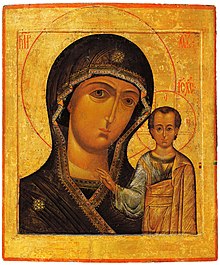 |
| Theotokos of Kazan |
In 1991, on the feast of the Dormition of the Mother of God (or the Assumption of Our Lady, as we call it), on August 15th by the Julian Calendar (or August 18th by our Gregorian Calendar), the belligerently atheistic regime of the Soviet empire came crashing down. After 70 years of anti-Christian propaganda from primary school to university and throughout all the available means of public communication from birth to the grave, the special troops refused to fire on the crowd after they had been told by the Patriarch of Moscow by a loud speaker that they would be cut off from Christ if they were to fire on unarmed civilians. He put Moscow under the protection of Our Lady of Kazan, and people throughout the crowd, even among the soldiers, crossed themselves. The KGB, who had attempted to stop the inevitable, knew they had lost. The crowd then went on to the KGB headquarters and pulled down the statue of the founder of the Soviet secret police and replaced it with a cross. On the base, someone sprayed the phrase, “By this sign, conquer!” in church slavonic. Christianity had returned to Russia.
As this happened on the feast of Our Lady's Assumption, and because the patriarch invoked the protection of the "Theotokos of Kazan, Protectress of Moscow", an ancient copy of whose icon hang in the shrine of Fatima, people remembered the words of Our Lady of Fatima that her Immaculate Heart would, one day, prevail over the atheistic, anti-Christian Russian regime, and that the conversion of Russia would herald the re-evangelisation of Europe. Pope John Paul II believed this, and he gave the Fatima icon of Our Lady of Kazan to the Russian Orthodox Church. I am pretty sure that this conviction fuelled his desire for reunion with the Russian Orthodox Church as well as his enthusiasm for the "new evangelisation". He connected the revival of the Church in Russia with the revival of the Christianity in Europe.
A tender gaze: Fatima trip shows pope's respect for pilgrims' faith
By Cindy Wooden Catholic News Service5.17.2017 9:20 AM ET
CNS/Paul Haring
Pope Francis places flowers near a statue of Mary as he prays in the Little Chapel of the Apparitions at the Shrine of Our Lady of Fatima in Portugal, May 12. The pope was making a two-day visit to Fatima to commemorate the 100th anniversary of the Marian apparitions and to canonize two of the young seers. (CNS photo/Paul Haring)
VATICAN CITY (CNS) -- Pope Francis is not shy about showing his love for Mary in public and, like many Latin American bishops, he strongly has resisted attempts to dismiss as superstitious or "simple," in a negative sense, popular devotion to the mother of God.
The pope's devotion and his respect for those who turn to Mary in their hour of need was on display May 12-13 when he and some 500,000 people gathered at the Shrine of Our Lady of Fatima in Portugal.
Canonizing two of the illiterate shepherd children to whom Mary appeared in 1917, Pope Francis made it clear he sees no need for people to be "sophisticated" in explaining their devotion.
But he also made it clear that, as in any area of faith and spirituality, there is room in their understanding of Mary for people to grow as Catholics and Christians.
Calling himself a pilgrim with the pilgrims, Pope Francis asked "which Mary" did the crowds come to honor? The Mary who is "a teacher of the spiritual life, the first to follow Jesus on the 'narrow way' of the cross by giving us an example, or a lady 'unapproachable' and impossible to imitate?"
For the pilgrims, he asked, is she "a woman 'blessed because she believed' always and everywhere in God's words or a 'plaster statue' from whom we beg favors at little cost?"
Pope Francis said many people would want to have a vision of Mary and to receive direct messages from her like Sts. Francisco and Jacinta Marto and their cousin, Sister Lucia dos Santos, did at Fatima in 1917.
However, he said, "the Virgin Mother did not come here so that we could see her. We will have all eternity for that, provided, of course, that we go to heaven."
Mary appeared at Fatima, he said, so that people would listen to her pleas that they pray more, do penance and follow Jesus more closely.
Like retired Pope Benedict XVI and St. John Paul II before him, Pope Francis teaches that Marian devotion is an important part of Catholic life, but always because she leads people to a deeper relationship with Christ.
Pope Francis sees a role for priests and bishops in challenging pilgrims to grow in their faith, but not to control how they express it.
In a letter to the Pontifical Commission for Latin America in 2016, Pope Francis said popular piety -- including Marian devotion -- is "one of the few areas in which the people of God are free from the influence of clericalism."
"It has been one of the few areas in which the people (including its pastors) and the Holy Spirit have been able to meet without the clericalism that seeks to control and restrain God's anointing of his own," the pope wrote. "Let us trust in our people, in their memory and in their 'sense of smell.' Let us trust that the Holy Spirit acts in and with our people and that this Spirit is not merely the 'property' of the ecclesial hierarchy."
Pope Francis is convinced that devotion to Mary and other popular expressions of faith are a largely uncultivated seedbed of evangelization. His conviction is so strong that April 1 he formally transferred responsibility for Catholic shrines from the Congregation for Clergy to the Pontifical Council for Promoting the New Evangelization.
"Despite the crisis of faith impacting the modern world, these places still are perceived as sacred spaces where pilgrims go to find moments of rest, silence and contemplation in the midst of a life that is often frenetic,"Pope Francis wrote:
The enduring popularity of Catholic shrines, "the humble and simple prayer of the people of God" and the Catholic liturgies celebrated in the shrines offer "a unique opportunity for evangelization in our time," he said.Many people today, he said, have a longing for God, and shrines "can be a true refuge" where people can be honest about themselves and "find the strength necessary for their conversion."
The decision to transfer responsibility for the shrines seems a natural consequence of what Pope Francis wrote in his first exhortation, "The Joy of the Gospel," which has an entire section on "the evangelizing power of popular piety."
Popular piety, he wrote in 2013, is a "true expression of the spontaneous missionary activity of the people of God," inspired and led by the Holy Spirit.
In the exhortation and at Fatima, Pope Francis celebrated the fact that Marian devotion and other forms of popular piety are particularly strong among the poor and humble, the very people with whom Mary identifies in the "Magnificat," her hymn of praise for how God lifts the lowly, fills the hungry with good things and sends the rich away empty.
Think, the pope wrote, "of the steadfast faith of those mothers tending their sick children who, though perhaps barely familiar with the articles of the creed, cling to a rosary; or of all the hope poured into a candle lighted in a humble home with a prayer for help from Mary, or in the gaze of tender love directed to Christ crucified."
THE VISIT OF PATRIARCH BARTHOLOMEW TO TAIZE
April 25, 2017
Words of Welcome by Brother Alois
On Tuesday 25 April 2017, His Holiness the Ecumenical Patriarch Bartholomew visited Taizé: an exceptional visit with the brothers, several Orthodox bishops and priests, representatives of the local Churches, and the young people present that week in Taizé. Here are the complete texts spoken by Brother Alois and Patriarch Bartholomew during the midday prayer.
Brother Alois’ Greeting To His Holiness the Ecumenical Patriarch Bartholomew
Your Holiness, Beloved Patriarch Bartholomew, by coming to our hill of Taizé you cause in us an extraordinary joy, since we are so attached to the Orthodox Church.
Since its origins, our community has been imbued with the Orthodox tradition. The centrality given to the resurrection of Christ and the role of the Holy Spirit, the strong reference to the teaching of the Church Fathers, the liturgical life, the contemplative life maintained by monasticism, the icons, the courage to go through decades of suffering across past centuries, all these values lived in the East have been and remain for us, the brothers of Taizé, unique sources of inspiration.
For years now, young Orthodox from various countries have come to participate in the weeks of meetings that succeed one another around our community. Their mere presence raises the question in the young Christians of the West whom they meet here: how can we receive and share to a greater extent the gifts deposited by God in the soul of Orthodox Christians?
Most Holy Father, I am sure that your venerable predecessor, the Patriarch of Constantinople Athenagoras, and the founder of our community, Brother Roger, are looking down at us and rejoicing with one heart. During their life on earth, a deep mutual trust enabled them to promote in 1962 the creation of an Orthodox monastic center in Taizé which was animated by the beloved Archimandrite Damaskinos, future Metropolitan of Switzerland, until he moved to Chambésy and set up the center whose fiftieth anniversary you have just celebrated.
Venerable Patriarch, I can not forget the warm welcome that you gave me and some of my brothers at Christmas 2005. Your affection supported our community, which was then undergoing a trial on account of the very recent violent death of its founder. Your welcome was just as warm when, a few years later, with a hundred young people from twenty-five countries, we went on pilgrimage to you.
Today we are the ones who welcome you with love and express our admiration. During your long ministry as patriarch, you have tirelessly worked for more than 25 years to make the treasures of the Orthodox faith relevant to the contemporary world. You have raised your voice in favor of an earth where all can live; you constantly recall that our relationships to creatures should reflect our relationship to the Creator. Your aspiration for Christian unity, your openness to interreligious dialogue and your experience of a crucified Church make you an irreplaceable witness to the peace of Christ.
And now we will sing and praise God, then we will listen to you, and you will bless two icons. Following this we will go to the small Orthodox chapel adjoining this Church of Reconciliation and then to the tomb of Brother Roger. We are touched and honored that, after that, you will share the fraternal meal of our community.
Thank you, beloved Patriarch, for being like a Father in faith for us.
Christ is risen!
Speech of His Holiness the Patriarch Bartholomew during the Common Prayer
Eminences,
Excellencies,
Dear Brother Alois,
Dear Brothers of the Community,
Ladies and gentlemen,
Dear friends,
Christ is risen!
For many years now we have felt the desire to come to Taizé, the seat of a spiritual ecumenism, a melting-pot of reconciliation, a meeting-place that, following the extraordinary vision of Brother Roger, its founder, inspires Christians to come together.
If this is the first time that an Ecumenical Patriarch of Constantinople visits your community—we are particularly pleased that this opportunity has been offered to us—Taizé’s ties with the Ecumenical Patriarchate go back a long way. Indeed, as early as 1962, Brother Roger had first visited the late Ecumenical Patriarch Athenagoras at Constantinople. Brother Roger quickly became a heart-brother of Orthodoxy, as the ecumenical mission he wished to bear largely embraced all the families of Christianity, each according to its own identity. We believe that to this day you have preserved the icon that the Ecumenical Patriarch Athenagoras entrusted to him. This icon of the Mother of God represents not only the spirit of fraternity that we are trying to make grow in the shadow of the protection of our common Mother, the Virgin Mary, but, more generally, the perspective in which our prayer in favor of the unity of Christians is situated. As if to mark the unbreakable link between Taizé and Orthodoxy, on April 15, 1963, the first stone of an Orthodox chapel was laid at Taizé, confirming with this gesture the immutable presence of Eastern Christianity within these walls.
You, dear Brother Alois, have faithfully summed up this beautiful tradition that unites us. We remember with emotion receiving you at Phanar twelve years ago on the feast of the Nativity of our Lord. On that occasion we were able to show you our strong attachment to the meetings of young people which you regularly organize at the turn of each year, as if to testify that the passage of time inexorably brings together divided Christians by allowing them to progress together on the way of unity . Every year, you do us the honor of conveying our message to the participants of the European meetings. We are particularly happy to be able to address these young European Christians who, for a few days, experience, even imperfectly, the communion to which we aspire. Did not Brother Roger like to say: “Christ did not come to earth to start a new religion, but to offer every human being a communion in God.”? Let us also mention the pilgrimages of trust on earth which form an important part of your ecumenical work.
Dear Brother Alois,
Today you are receiving us in this beautiful Church of Reconciliation. The theme of reconciliation is central to Christianity and in our opinion we must distinguish three levels of reading. The first level is the relationship of the reconciliation of the human with the divine. The work of Christ in the world is a work of reconciliation that goes beyond religion in that it links vertically and horizontally the Creator and creatures. Reconciliation in Christ places him at the center of what humankind accomplishes as an image of God and in a dynamic relationship of resemblance. Christ is reconciliation. Remember the words of the Holy Apostle Paul: “For it was God who in Christ reconciled the world to himself, not imputing people’s sins to them, and putting the word of reconciliation in us.” (2 Corinthians 5:19) It is interesting to note that Saint Paul, in the preceding verse, speaks of a “ministry of reconciliation.” (2 Cor 5:18) Reconciliation is the yardstick by which we must measure our communion with God and our unity in the Church.
The second level stems directly from the “ministry of communion” that we have just mentioned. In fact, it is more ecumenical. It responds to the commitment to Christian unity in which the reconciliatory action we have to undertake takes its place. If we were to use only one image, we would use that of healing. To reconcile is above all to heal the evils of history, the scars of time, mutual misunderstandings, conflicts of memory, fratricidal hatreds. In this sense, the division between Christians to which we intend to respond by praying for the unity of the Churches is a spiritual wound, with shared responsibilities—whether accepted or not. Indeed, in the ecumenical era and at the time of the search for unity, there can be no reconciliation without forgiveness. Besides, for St. John Chrysostom, reconciliation cannot be put off. If we want to be true actors of reconciliation, we must assume our responsibilities and be ready to take the first step.
The third level, on the other hand, is more global. The love of Christ, the very man who urges us towards this reconciliation, encompasses all humanity. Reconciliation becomes an agent of peace, a lever to overcome historical antagonisms, a means of neutralizing the polarizations of the global social landscape and defusing conflicts. Reconciliation is therefore a global issue for our Churches and for the world at large. Let us quote this beautiful Lutheran-Catholic text, “From Conflict to Communion”, which, at this time of commemoration of the 500th anniversary of the Reformation, perfectly accounts for the spiritual and ecumenical path that the principle of “reconciliation” involves . “The ecumenical commitment to the unity of the Church does not only benefit the Church, but also the world, so that the world may believe. The more our societies become pluralistic in terms of religions, the greater the missionary task of ecumenism. Here again it is necessary to rethink things and to repent.” (Para. 243)
The challenge of reconciliation goes beyond the historical event that the Orthodox Church experienced during the Holy and Great Council meeting in Crete in June 2016. It was indeed not only a matter of studying the themes on the agenda, however important they may have been, but of dealing with the reality and the place of Orthodoxy as a whole in the contemporary world. In an age of globalization, the Orthodox Church must be able to equip itself with the tools to meet the challenges posed by modernity. The Holy and Great Council was a pivotal event, for it was at the same time an ecclesial phenomenon of communion, which manifests the unity of all Orthodoxy—this unity was not questioned by the autocephalic Orthodox Churches which did not participate because of the theological principle of catholicity—and the absolute necessity of a conciliar experience on a planetary level. Conciliarity, although traditional in Orthodoxy at local and regional levels, remains to be (re)discovered today on a global scale. We therefore thank God for the Holy and Great Council and hope that it is simply the starting-point of the renewed exercise of conciliarity as a synonym for the life of the Church. As we can read in the Message of the Holy and Great Council: “The Orthodox Church expresses its unity and its catholicity in the Council. Its conciliarity shapes its organization, the way in which it makes decisions and determines its destiny.”
Dear friends,
In order to understand what Taizé represents for the Orthodox Church, let us turn to Olivier Clement for a moment. In his beautiful work Taizé: a Meaning to Life, the Orthodox theologian did not regard Taizé as a community in the institutional sense; it is also, and perhaps first of all, an event. The “Taizé event” crystallizes, according to him, the aspirations of youth in search of being, in search of belief, in search of life. The “Taizé event” acts as a powerful parable of conversion and reconciliation, focusing on the inner life that allows us to enter into the mystery of unity while fully subscribing to the life of the world. Olivier Clement wrote in particular: “Prayer does not free us from the tasks of this world: it makes us even more responsible. Nothing is more responsible than to pray.”
These words resound with power in the Orthodox tradition and lead us to deepen the meaning of reconciliation through the mystery of the resurrection. The liturgical time in which we find ourselves invites us to this all the more strongly, since here we touch the roots of the mystery of the Christian faith. Saint Irenaeus of Lyons wrote: “But in fact, through the communion we have with him, the Lord has reconciled man with the Father, reconciling us to himself by his body of flesh and redeeming us by his blood....” (Adv. Haer, V, 14, 3)
By his death and resurrection, Christ reconciled us to God. As we sing the Easter hymns, Eastern and Western Christians together, let us continue to pray that the light of the resurrection will lead us on the path of unity and communion.
Thank you for having us here today.
Christ is risen!
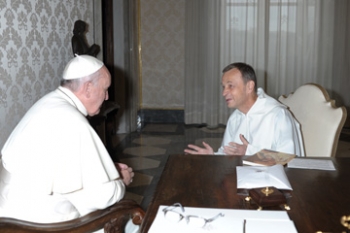
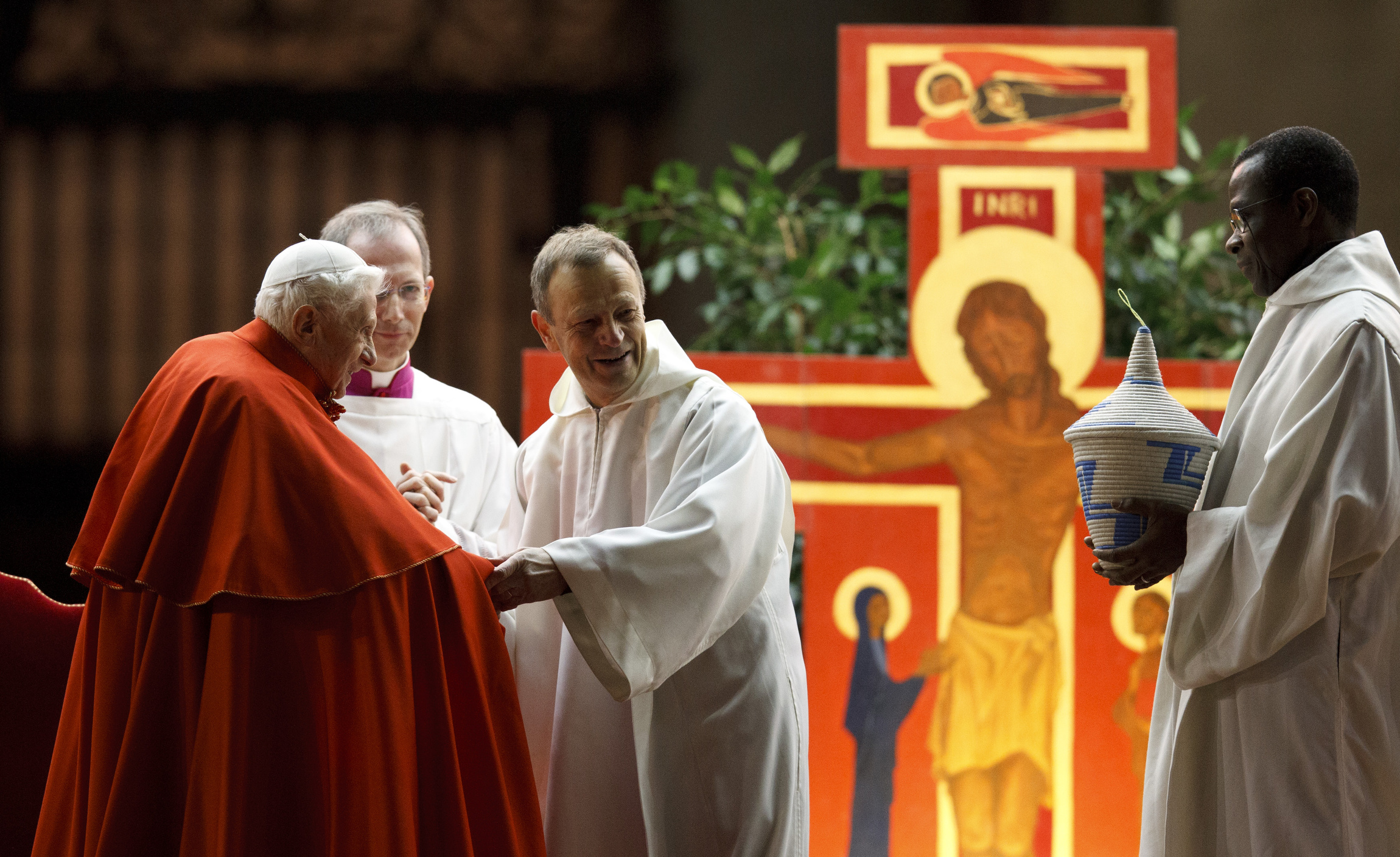
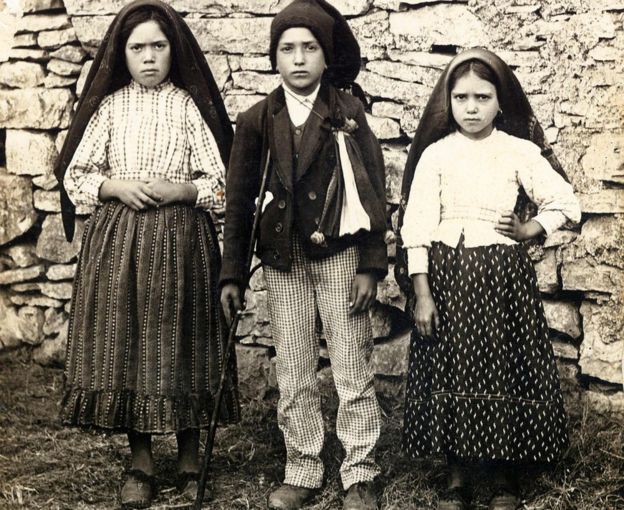
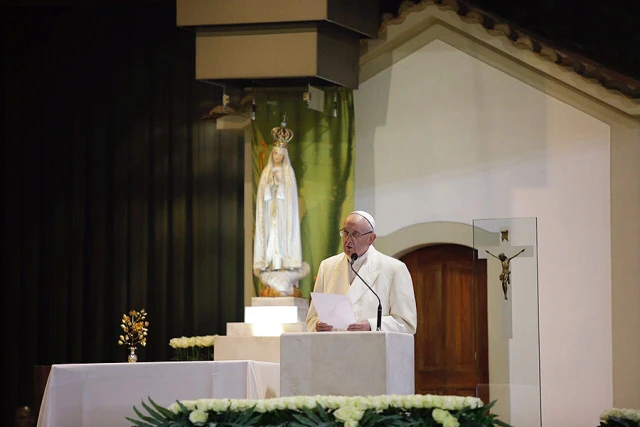

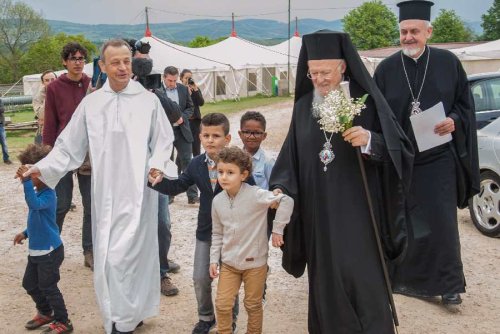
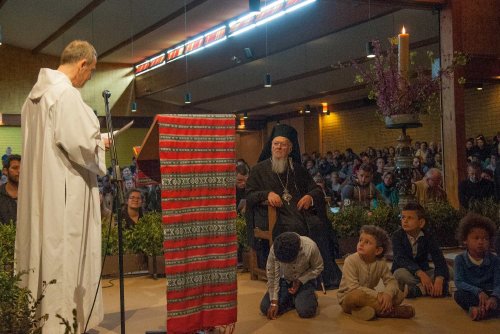

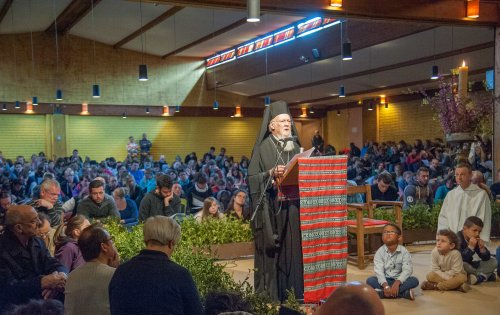





No comments:
Post a Comment